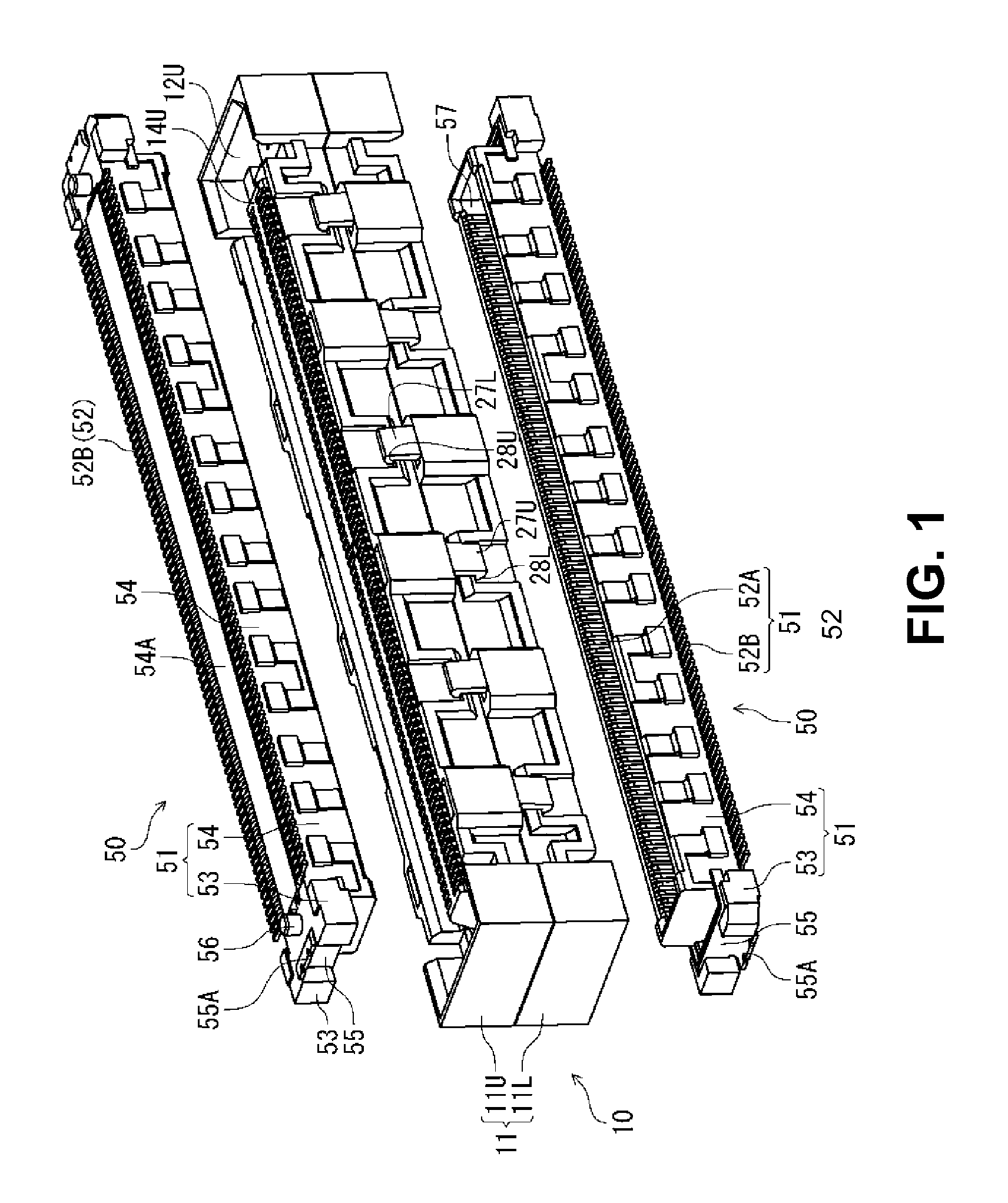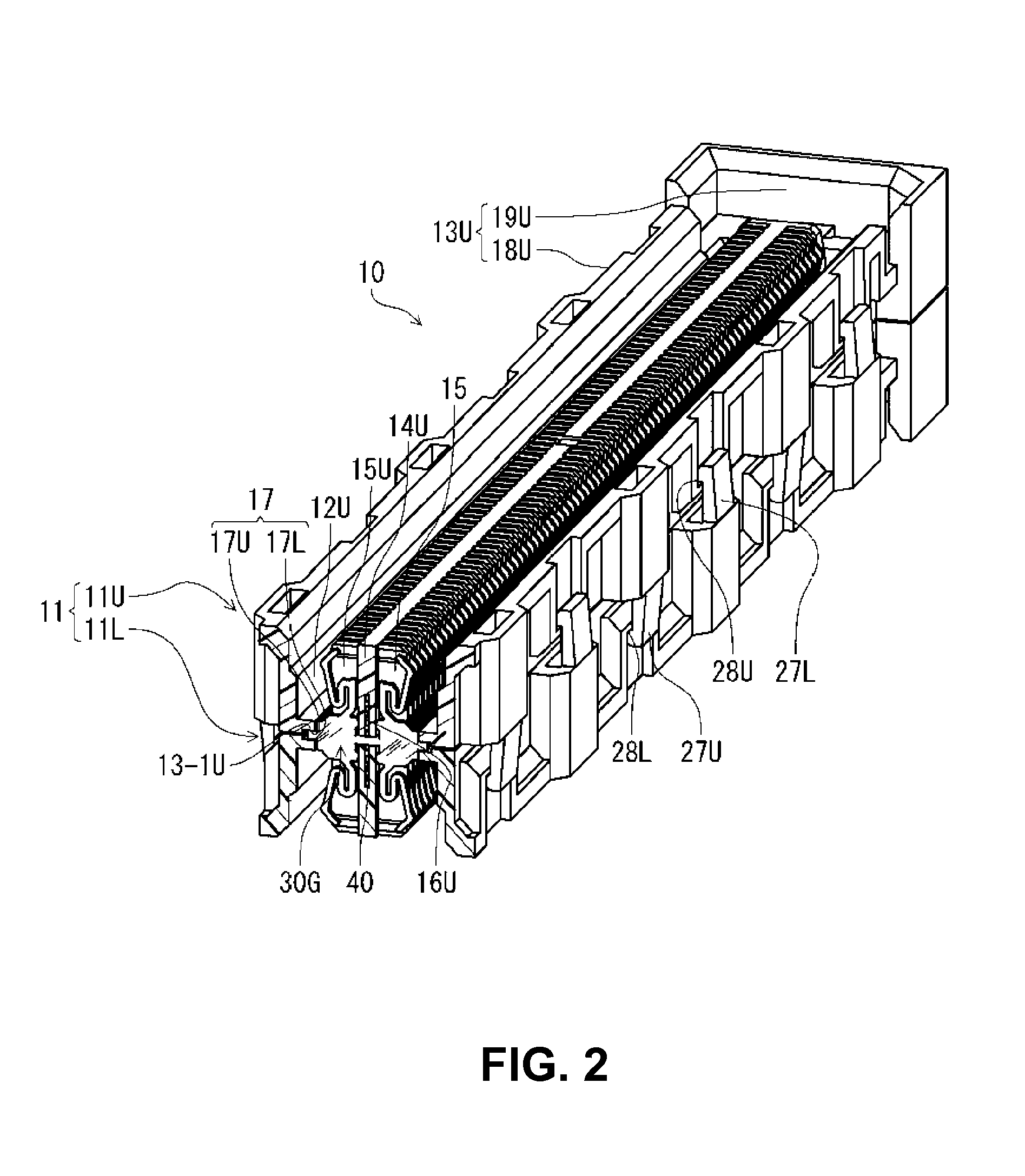Electrical connector and electrical connector assembled component
a technology of electrical connectors and components, applied in the direction of coupling devices, two-part coupling devices, coupling device connections, etc., can solve the problems of affecting the service life of the connector, the resistance of the elastic displacement tends to be strong, and the difficulty in obtaining the floating to a sufficient exten
- Summary
- Abstract
- Description
- Claims
- Application Information
AI Technical Summary
Benefits of technology
Problems solved by technology
Method used
Image
Examples
first embodiment
[0037]A first embodiment of the present invention will be explained. FIG. 1 is a perspective view showing outer appearance of the electrical connector assembled component formed of an electrical connector of the present invention and two mating connectors, right before assembling.
[0038]In the electrical connector assembled component of FIG. 1, two mating connectors 50 having the same configuration are disposed above and below an electrical connector 10 of this embodiment before fitting those mating connectors 50 to the electrical connector 10 for assembling, in which one of the mating connectors 50 is flipped upside down relative to the other. Then, the mating connectors 50 are fitted to the electrical connector 10 from thereabove and from thereunder for the assembling.
[0039]In the embodiment, as shown in FIG. 1, the mating connectors 50 have a same configuration and are to be fitted to the connector 10 while the mating connectors 50 are respectively mounted on circuit boards (not i...
second embodiment
[0090]A second embodiment of the present invention will be explained next. The first embodiment shown in FIGS. 1-9 and described above can be altered, modified, and changed. For example, it is possible to form the grounding connection members 40 as generally plate-like members and function as grounding plates. The grounding connection members 40 shown in FIG. 10 include the upper and the lower grounding members 40U and 40L, but also in this case, the upper and the lower grounding connection members 40U and 40L have the same configuration and are disposed simply flipping one of them upside down relative to the other as shown in FIG. 10(A). Therefore, the embodiment will be described referring to the upper grounding connection member 40U.
[0091]An upper edge of the upper grounding connection member 40U includes a flat strip-like section to be held 41U that extends in the connector's longitudinal direction, and a thin elastic sections 42U that extend diagonally from an upper edge of the...
third embodiment
[0095]A third embodiment of the present invention will be explained next. Not only in an intermediate connector for connecting the upper and lower mating connector as shown in those figures, it is also possible to apply the present invention in other types of intermediate connectors, for example the one, in which the mating connectors are disposed being capable of inserting / removing in perpendicular direction.
[0096]For example, in FIG. 11, the connector 10 that functions as an intermediate connector includes the lower housing 11L to fit the lower mating connector 50 from thereunder, and the upper housing 11U for fitting the upper mating connector 50 in the lateral direction (from the right side in the figure). The upper housing 11U is joined to the lower housing 11L from thereabove. In other words, the splitting surface where the upper housing 11U and the lower housing 11L contact by surface is in a horizontal direction, and although the position of the splitting surface is the same...
PUM
 Login to View More
Login to View More Abstract
Description
Claims
Application Information
 Login to View More
Login to View More - R&D
- Intellectual Property
- Life Sciences
- Materials
- Tech Scout
- Unparalleled Data Quality
- Higher Quality Content
- 60% Fewer Hallucinations
Browse by: Latest US Patents, China's latest patents, Technical Efficacy Thesaurus, Application Domain, Technology Topic, Popular Technical Reports.
© 2025 PatSnap. All rights reserved.Legal|Privacy policy|Modern Slavery Act Transparency Statement|Sitemap|About US| Contact US: help@patsnap.com



